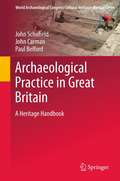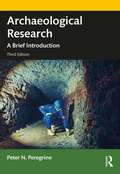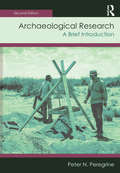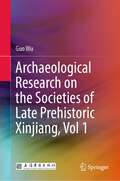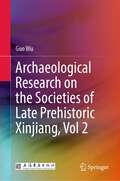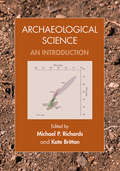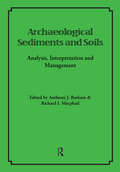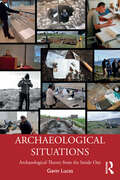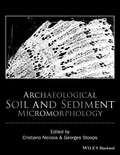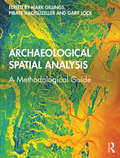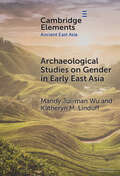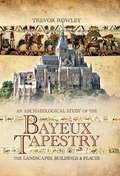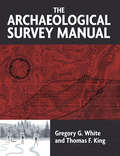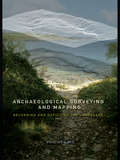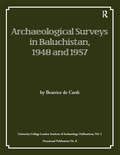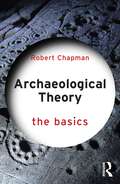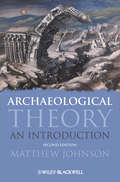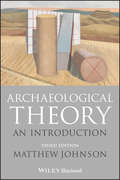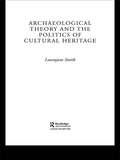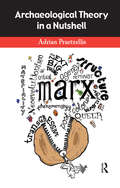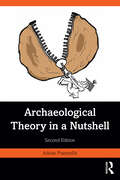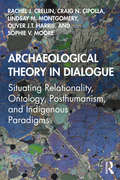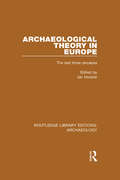- Table View
- List View
Archaeological Practice in Great Britain: A Heritage Handbook (World Archaeological Congress Cultural Heritage Manual Series)
by John Schofield Paul Belford John CarmenThis manual provides a unique 'user guide' to practicing archaeology and working in the cultural heritage sector within the diverse settings of Great Britain, comprising of: England, Scotland, Wales, the Isle of Man and the Channel Islands. As part of their training, archaeologists often seek work in parts of Britain, either for experience before travelling elsewhere, or directly as part of their career progression. While this does involve reading published material on excavation techniques, archaeological theory, and specific heritage management practices, or research using the Internet, the ideal preparation to working in Britain for the first time requires practitioners to know a little about a lot. Currently, there is no single resource which provides that primary resource for budding archaeologists. Archaeological Practice in Great Britain will provide just such a resource: presented in an accessible style, with a comprehensive and up-to-date bibliography and lists of useful websites. Professionals with particular areas of expertise will contribute short sections on particular subjects, incorporated into the main text prepared by the authors. Throughout, the specific contexts and differences between the various component nations and regions of Great Britain will be made clear.
Archaeological Research: A Brief Introduction
by Peter PeregrineThe third edition of Archaeological Research introduces the basic methods of archaeological research, including data collection, analysis, and interpretation, as well as considering the state of the field today. With new sections on curating archaeological collections and public archaeology, the third edition also adds a new chapter on the analysis of metals and glass. This popular, concise textbook examines approaches to the archaeological record, sampling and research design, survey and excavation methods and strategies, recordkeeping, dating and analysis of archaeological materials, and the professional practice of archaeology. Archaeological Research continues to be an excellent text for undergraduate students in basic archaeology courses, field methods courses, and field schools.
Archaeological Research: A Brief Introduction
by Peter N. PeregrineThis updated edition of Archaeological Research introduces the basic methods of archaeological research, including data collection, analysis, interpretation, as well as a consideration of the state of archaeology today. New to the Second Edition is updated information on geographic information systems and remote sensing strategies, and a greatly expanded discussion of practices in cultural resource management archaeology. This popular, concise textbook explores various research methods, analytical techniques, legal and ethical issues facing archaeologists; includes discussions of the archaeological process and record, sampling and research design, survey and excavation methods and strategies, recordkeeping, analysis, archaeological dating, presenting results, and research opportunities; is an excellent text for undergraduate students in basic archaeology courses, field methods courses, and field schools
Archaeological Research on the Societies of Late Prehistoric Xinjiang, Vol 1
by Guo WuThis book presents cutting-edge archaeological materials from Xinjiang, from the Bronze Age to the early Iron Age. Through a systematic topological study of major archaeological cemeteries and sites, it establishes chronologies and cultural sequences for three main regions in Xinjiang, namely the circum-Eastern Tianshan region, the circum-Dzungarian Basin region and the circum-Tarim Basin region. It also discusses the origins and local variants of prehistoric archaeological cultures in these regions and the mutual relationships between them and neighboring cultures.By doing so, the book offers a panoramic view of the socio-cultural changes that took place in prehistoric Xinjiang from pastoral-agricultural societies to the mobile nomadic-pastoralist states in the steppe regions and the agricultural states of the oasis, making it a must-read for researchers and general readers who are interested in the archaeology of Xinjiang.
Archaeological Research on the Societies of Late Prehistoric Xinjiang, Vol 2
by Guo WuThis book presents cutting-edge archaeological materials from Xinjiang, from the Bronze Age to the early Iron Age. Through a systematic topological study of major archaeological cemeteries and sites, it establishes chronologies and cultural sequences for three main regions in Xinjiang, namely the circum-Eastern Tianshan region, the circum-Dzungarian Basin region and the circum-Tarim Basin region. It also discusses the origins and local variants of prehistoric archaeological cultures in these regions and the mutual relationships between them and neighboring cultures.By doing so, the book offers a panoramic view of the socio-cultural changes that took place in prehistoric Xinjiang from pastoral-agricultural societies to the mobile nomadic-pastoralist states in the steppe regions and the agricultural states of the oasis, making it a must-read for researchers and general readers who are interested in the archaeology of Xinjiang.
Archaeological Resource Management
by John CarmanArchaeological resource management (ARM) is the practice of recording, evaluating, preserving for future research and presenting to the public the material remains of the past. Almost all countries uphold a set of principles and laws for the preservation and professional management of archaeological remains. This book offers a critical and comparative perspective on the law and professional practices of managing archaeological remains. Beginning with a global history of ARM, John Carman provides an overview of legal and professional regulations governing ARM today. He then turns to consider the main practices involved in managing archaeological remains, namely, their identification and recording, their evaluation for 'significance', their preservation and their presentation to the public. As a whole, the book offers an overview of what ARM 'does' in the world, with implications for understanding the role of archaeology as a contemporary set of practices that determine how future generations will access material remains of the past.
Archaeological Science: An Introduction
by Michael P. Richards Kate BrittonThis book provides an up to date introduction to the exciting, but complex, new scientific methodologies that are increasingly used in archaeological study. Written by an international team of specialists, it provides clear and engaging overviews of a wide array of approaches, including DNA and proteomics, dating methods, materials analysis, stable isotope analysis, and the scientific study of human, plant, and animal remains, among other topics. Each technique is explored through the use of actual archaeological examples, which both explain the methods and highlight their potential applications. The work is carefully illustrated with useful charts, graphs and other images, which complement the detail in the text, and help to articulate the case studies explored as well as the underlying principles of the techniques involved. Feature tables in many of the chapters highlight selected research on each topic, providing useful summaries of the current state and scope of the field for the reader. This volume will serve as a handy reference tool for scholars, as well as a key textbook for courses on archaeological science.
Archaeological Sediments and Soils: Analysis, Interpretation and Management (UCL Institute of Archaeology Publications)
by Richard I. Macphail Anthony J. BarhamA collection of papers focusing on the links between archaeology and the study of geological sediments and soils.
Archaeological Situations: Archaeological Theory from the Inside Out
by Gavin LucasThis book is an introduction to theory in archaeology – but with a difference. Archaeological Situations avoids talking about theory as if it was something you apply but rather as something embedded in archaeological practice from the start. Rather than see theory as something worked from the outside in, this book explores theory from the inside out, which means it focuses on specific archaeological practices rather than specific theories. It starts from the kinds of situations that students find themselves in and learn about in other archaeology courses, avoiding the gap between practice and theory from the very beginning. It shows students the theoretical implications of almost everything they engage in as archaeologists, from fieldwork, recording, writing up and making and assessing an argument to exploring the very nature of archaeology and justifying its relevance. Essentially, it adopts a structure which attempts to pre-empt one of the most common complaints of students taking theory courses: how is this applicable? Aimed primarily at undergraduates, this book is the ideal way to engage students with archaeological theory.
Archaeological Soil and Sediment Micromorphology
by Cristiano Nicosia Georges StoopsArchaeological Soil and Sediment Micromorphology goes beyond a mere review of current literature and features the most up to date contributions from numerous scientists working in the field. The book represents a groundbreaking and comprehensive resource covering the plethora of applications of micromorphology in archaeology. Archaeological Soil and Sediment Micromorphology offers researchers, students and professionals a systematic tool for the interpretation of thin sections of archaeological contexts. This important resource is also designed to help stimulate the use of micromorphology in archaeology outside Europe, where the technique is less frequently employed. Moreover, the authors hope to strengthen the proper application of soil micromorphology in archaeology, by illustrating its possibilities and referring in several cases to more specialized publications (for instance in the field of plant remains, pottery and phytoliths). Written for anyone interested in the topic, this important text offers: Contributions from most of the world's leading authorities on soil micromorphology A series of chapters on the major topics selected among the most recurrent in literature about archaeological soil micromorphology Systematic descriptions of all important micromorphological features Special analytical tools employed on thin sections, such as SEM/EDS, image analysis, fluorescence microscopy, mass spectrometry, among others Numerous cross-references 400 illustrated full-colour plates The resource provides the most current and essential information for archaeologists, geoarchaeologists, soil scientists and sedimentologists. Comprehensive in scope, Archaeological Soil and Sediment Micromorphology offers professionals and students a much-needed tool for the interpretation of thin sections of archaeological contexts.
Archaeological Spatial Analysis: A Methodological Guide
by Mark Gillings Piraye Hacıgüzeller Gary LockEffective spatial analysis is an essential element of archaeological research; this book is a unique guide to choosing the appropriate technique, applying it correctly and understanding its implications both theoretically and practically. Focusing upon the key techniques used in archaeological spatial analysis, this book provides the authoritative, yet accessible, methodological guide to the subject which has thus far been missing from the corpus. Each chapter tackles a specific technique or application area and follows a clear and coherent structure. First is a richly referenced introduction to the particular technique, followed by a detailed description of the methodology, then an archaeological case study to illustrate the application of the technique, and conclusions that point to the implications and potential of the technique within archaeology. The book is designed to function as the main textbook for archaeological spatial analysis courses at undergraduate and post-graduate level, while its user-friendly structure makes it also suitable for self-learning by archaeology students as well as researchers and professionals.
Archaeological Studies on Gender in Early East Asia (Elements in Ancient East Asia)
by Mandy Jui-man Wu Katheryn M. LinduffGendered archaeology in Asia has been studied by archaeologists since the 1990s and scholars have posed questions such as the role and construction of gendered identities in ancient societies. In this Element, the authors review secondary literature, report on to what stage the research has evolved, evaluate methodologies, and use the concept of networking to examine the issues across East Asia, including China, Mongolia, Korea, Japan, and Taiwan. Interestingly, those literatures are not entirely parallel with each other – the authors found, for example, that archaeological investigation was largely bound by national guidelines, by local intellectual traditions, and by changing historiographic interpretations of past events, as well as funding. The complexion of recent studies on gender and archaeology in Asia has often been focused on providing a framework for a grand narrative of each national 'civilization' as the emergence of institutional political structures, including traditional values placed on men and women.
An Archaeological Study of the Bayeux Tapestry: The Landscapes, Buildings and Places
by Trevor RowleyAn analysis of the famed medieval English tapestry through examination of the depicted landscapes, towns, castles, and other structures.An Archaeological Study of the Bayeux Tapestry provides a unique re-examination of this famous piece of work through the historical geography and archaeology of the tapestry. Trevor Rowley is the first author to have analyzed the tapestry through the landscapes, buildings and structures shown, such as towns and castles, while comparing them to the landscapes, buildings, ruins and earthworks which can be seen today. By comparing illustrated extracts from the tapestry to historical and contemporary illustrations, maps and reconstructions Rowley is able to provide the reader with a unique visual setting against which they are able to place the events on the tapestry. This approach allows Rowley to challenge a number of generally accepted assumptions regarding the location of several scenes in the tapestry, most controversially suggesting that William may never have gone to Hastings at all. Finally, Rowley tackles the missing end of the tapestry, suggesting the places and events which would have been depicted on this portion of William&’s journey to Westminster.Praise forAn Archaeological Study of the Bayeux Tapestry &“We all know what the Bayeux Tapestry celebrates in its iconic artwork, but Trevor Rowley goes one step further and looks at the buildings and characters with a view actually identifying them! Absolutely fascinating, brings a whole new dimension to the study of this amazing artefact.&” —Books Monthly &“Rowley&’s arguments are copiously illustrated with details from the tapestry, photographs and plans. It results in very densely packed chapters well worth reading, and you certainly will never look at that tea towel in the same way again.&” —Hexham Local History Society
The Archaeological Survey Manual
by Thomas F King Gregory G WhiteGovernmental guidelines have forced a dramatic change in the practice of archaeological surveying in recent decades. In response to public and private development, surveying is needed to accurately inventory the cultural resources of a region and provide guidance for their preservation and management. Greg White and Tom King provide a handy introduction to students, field novices, and land managers on the strategies, methods, and logic of contemporary survey work. In addition to providing the legal and historical context for this endeavor the book provides a heavily illustrated, practical guide to conducting a survey to help beginners understand how it works in practice. This volume is perfect for an archaeological methods class, field school, or reference collection.
The Archaeological Survey Manual
by Gregory G White Thomas F KingGovernmental guidelines have forced a dramatic change in the practice of archaeological surveying in recent decades. In response to public and private development, surveying is needed to accurately inventory the cultural resources of a region and provide guidance for their preservation and management. Greg White and Tom King provide a handy introduction to students, field novices, and land managers on the strategies, methods, and logic of contemporary survey work. In addition to providing the legal and historical context for this endeavor the book provides a heavily illustrated, practical guide to conducting a survey to help beginners understand how it works in practice. This volume is perfect for an archaeological methods class, field school, or reference collection.
Archaeological Surveying and Mapping: Recording and Depicting the Landscape
by Philip HowardA comprehensive and practical guide to surveying for archaeologists, with clear instructions in archaeological mapping, recording field work and detailed case studies from the UK, Europe and the US. Philip Howard provides a user’s guide to methods and instruments of surveying to enable archaeologists to represent their own fieldwork confidently and independently. Archaeological Surveying is an invaluable resource which: provides beginner’s instructions to software used in computerised surveying, including IntelliCAD 2000, Terrain Tools, Christine GIS and Global Mapper introduces the archaeologist to a range of surveying instruments such as GPS, electronic distance measures, theodolites and magnetic compasses includes low-cost software. This textbook is an essential read for any field archaeologists who are in need of an introduction to surveying, or simply wish to update their techniques.
Archaeological Surveys in Baluchistan, 1948 and 1957 (UCL Institute of Archaeology Publications)
by Beatrice de CardiFinal report of a key set of archaeological surveys in a previously unstudied area of eastern Iran by one of the pioneer archaeologists of this region.
Archaeological Theory: The Basics (The Basics)
by Robert ChapmanArchaeological Theory: The Basics is an accessible introduction to an indispensable part of what archaeologists do. The book guides the reader to an understanding of what theory is, how it works and the range of theories used in archaeology. The growth of theory and the adoption of theories drawn from both the natural and social sciences have broadened our ability to produce trustworthy knowledge about the past. This book helps readers to see the value of archaeological theory and beyond what is sometimes thought to be just the use of indigestible jargon. Key theories and concepts are introduced to the reader. Among the main questions discussed are the following: What is theory and why do we need it? What major areas of theory are, and have been, used and debated in archaeology? What do they tell us about themes including human society, evolution, culture, identity and agency? How might archaeological theory change in the future? This book is written mainly for readers new to archaeology and will help them to understand archaeological theory. It assumes no prior knowledge of archaeological theory and presents it in a selective and clear way, with case studies showing how theory is used in practice.
Archaeological Theory: An Introduction
by Matthew JohnsonArchaeological Theory, 2nd Edition is the most current and comprehensive introduction to the field available. Thoroughly revised and updated, this engaging text offers students an ideal entry point to the major concepts and ongoing debates in archaeological research. New edition of a popular introductory text that explores the increasing diversity of approaches to archaeological theory Features more extended coverage of 'traditional' or culture-historical archaeology Examines theory across the English-speaking world and beyond Offers greatly expanded coverage of evolutionary theory, divided into sociocultural and Darwinist approaches Includes an expanded glossary, bibliography, and useful suggestions for further readings
Archaeological Theory: An Introduction (Wiley Desktop Editions Ser.)
by Matthew JohnsonA lively and accessible introduction to themes and debates in archaeological theory for students of all levels Archaeological Theory is a relatable, accessible, reader-friendly first step into the world of theory for archaeology students. Recognizing that many students shy away from the study of theory for fear that the material is too difficult or obscure, Archaeological Theory maintains that any student can develop an understanding of theory and that a knowledge of theory will lead to better practice. As one of the leading texts for introductory courses in archaeology and archaeological theory, it has provided many students with the essential foundation for a complete education in the discipline. With a focus on clarifying the history and development of archaeological theory, this valuable text serves as a roadmap to the different schools of theory in archaeology, clarifying the foundations of these schools of thought, the relationships between them, and the ideas that distinguish each from the other. Students will also learn about the relationship between archaeology and cultural and political developments, the origins of New and ‘post-processual’ archaeology, and current issues shaping the field. Written in a clear and informal style and incorporating examples, cartoons, and dialogues, this text provides an ideal introduction for students at all levels. The revised third edition has been updated with new and revised chapters and an expanded glossary and bibliography, as well as new readings to guide further study. Engages readers with informal and easy-to-understand prose, as well as examples, cartoons, and informal dialogues Prepares students to understand complex topics and current and perennial issues in the field such as epistemology, agency, and materiality in the context of archaeological practice Discusses current developments in associated disciplines New and revised chapters on the material turn, politics and other issues, and an expanded glossary and bibliography with updated reading suggestions Offers expanded coverage of materiality, cultural-historical archaeology, evolutionary theory, and the work of scholars of diverse backgrounds and specializations Engaging and illuminating, Archaeological Theory is an indispensable resource for undergraduate and graduate students in archaeology and related disciplines.
Archaeological Theory and the Politics of Cultural Heritage
by Laurajane SmithThis controversial book is a survey of how relationships between indigenous peoples and the archaeological establishment have got into difficulty, and a crucial pointer to how to move forward from this point. With lucid appraisals of key debates such as NAGPRA, Kennewick and the repatriation of Tasmanian artefacts, Laurajane Smith dissects the nature and consequences of this clash of cultures. Smith explores how indigenous communities in the USA and Australia have confronted the pre-eminence of archaeological theory and discourse in the way the material remains of their past are cared for and controlled, and how this has challenged traditional archaeological thought and practice. Essential reading for all those concerned with developing a just and equal dialogue between the two parties, and the role of archaeology in the research and management of their heritage.
Archaeological Theory in a Nutshell
by Adrian PraetzellisAdrian Praetzellis provides a brief, readable introduction to contemporary theoretical models used in archaeology for the undergraduate or beginning graduate student. He demystifies a dozen flavors of contemporary theory for the theory-phobic reader, providing a short history of each, its application in archaeology, and an example of its use in recent work. The book: teaches about different contemporary archaeological theories including postcolonialism, neoevolutionism, materiality, and queer theoy is written in accessible language with key examples for each theory includes illustrations and cartoons by the author provides questions at the end of each chapter to facilitate discussion.
Archaeological Theory in a Nutshell
by Adrian PraetzellisThis book provides a brief, readable introduction to archaeological theory. Adrian Praetzellis demystifies a pile of tricky contemporary concepts for the theory-phobic undergraduate or beginning graduate student. This new edition adds chapters on Indigenous, cognitive, and behavioral archaeologies and now covers 15 contemporary theories from neoevolutionism to queer theory. Each chapter begins with a description of the concept, its origin and significance. Next up is an example of how an archaeologist has used the idea to understand their site, making the connection between the idea and the archaeology plain and unambiguous. Each chapter ends with discussion questions and suggestions for further reading. A glossary of postmodern discourse (including that word) concludes the book. Using plain English to clarify some of the more baffling ideas used in contemporary archaeology, this book is a vital resource for students studying archaeological theory and the discipline as a whole.
Archaeological Theory in Dialogue: Situating Relationality, Ontology, Posthumanism, and Indigenous Paradigms
by Rachel J. Crellin Craig N. Cipolla Lindsay M. Montgomery Oliver J.T. Harris Sophie V. MooreArchaeological Theory in Dialogue presents an innovative conversation between five scholars from different backgrounds on a range of central issues facing archaeology today. Interspersing detailed investigations of critical theoretical issues with dialogues between the authors, the book interrogates the importance of four themes at the heart of much contemporary theoretical debate: relations, ontology, posthumanism, and Indigenous paradigms. The authors, who work in Europe and North America, explore how these themes are shaping the ways that archaeologists conduct fieldwork, conceptualize the past, and engage with the political and ethical challenges that our discipline faces in the twenty-first century. The unique style of Archaeological Theory in Dialogue, switching between detailed arguments and dialogical exchange, makes it essential reading for both scholars and students of archaeological theory and those with an interest in the politics and ethics of the past.
Archaeological Theory in Europe: The Last Three Decades (Routledge Library Editions: Archaeology)
by Ian HodderThe 1980s witnessed exciting developments in theoretical writing in Western archaeology. Where previous decades were dominated by the Anglo-American perspective, or "New Archaeology", the recent years showed the European debate grow in confidence and vitality. This book, published in 1991, captures this spirit of debate as contributors from a wide cross-section of countries evaluate the development of the distinctly national and European characteristics of archaeology and assess future directions. Contributors consider an extensive range of ideologies and viewpoints, stressing the fundamentally historical emphasis and social construction of European archaeology. The development of archaeological theory is traced, with specific emphasis on factors which differ from country to country. Ultimately, it argues that the most active response to archaeology is to celebrate theory within a constantly critical mode. A great insight into the development of theory.
